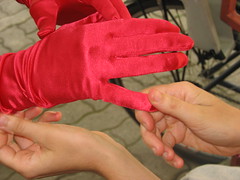



(images (CC), found on Flickr; by Huro Kitty, Sue Richards, Pernell, (C) David Fred)
If you look at the articles in the Ubicomp conference proceedings, you'll find them dominated by location sensing and tracking. Clearly, ubicomp is still about figuring where you are in a space. But what happens when you've done that? What happens to designing the user experience when you know location?
I'm trying to wrap my brain around what it means to design in this environment. Recently I tried to put some boundaries around the complexity with a simple powers-of-ten granularity scale. The goal is to define some classes of experience for which we can design and then assign a term to each class (from the words that regularly come up in discussions of ubicomp/ambient intelligence/geolocation, etc.). Basically, we may not know whether the fruit are apples or oranges, but at least we can say whether they're big or little.
This technique is, of course, indebted to two classics:
- the Eames Powers of Ten film
- PARC's inch/foot/yard scale in designing their ParcTab/ParcPad and Liveboard
The scale
| Scale | Label | Examples |
| 1 cm | covert | RFID, nail polish, cochlear implant |
| 10 cm | mobile | phone handset, portable media player, wallet |
| 1 m | personal | chair, car, ATM, payphone |
| 10 m | environmental | wall, door, chandelier |
| 100 m | architectural | church clock, billboard, bus |
| 1000 m | urban | street intersection, landmark, crowd |
(note: I'm using metric units because, well, they're designed to work as powers of ten. I'm not playing favorites among measurement systems, because, well, I like the English system a lot because of its excellent pre-Enlightenment idiosyncrasies)
My goal is to create a user-centered hierarchy (rather than hardware-centric) as a way of talking about the perceived effects of ubiquitous computing technologies. In other words, this is an attempt to talk (roughly) about end users' radius of focus in the moment as a way to design for that moment. Thus, these granularities do not necessarily refer to the size of the device, but to the range of effect that device has and the task being investigated. For example, video projector control panels are on the mobile scale, but a big video projector's industrial design can easily be on the personal scale, while its effects are usually on the environmental.
Undoubtedly, like with any classification scheme, there are going to be plenty of things that fall in between, but this is a classification exercise, rather than an attempt to create a canonical classification.



